
It seems like 2022 was a busy year in data storage and that was reflected on the white paper and research report front. Below is a compilation of my top 6 favorites from this past calendar year that I am glad to share for easy access. Happy reading and Happy New Year!
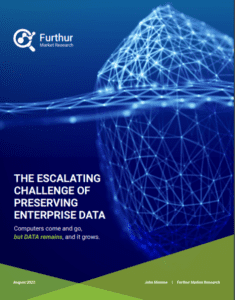 John Monroe, a long-time storage industry expert and Gartner analyst turned independent consultant, published a report in August 2022 entitled, The Escalating Challenge of Preserving Enterprise Data. The report looks at the supply and demand for SSD, HDD and tape technologies from 2022 to 2030. The findings and conclusions in John’s report are surprising to say the least!
John Monroe, a long-time storage industry expert and Gartner analyst turned independent consultant, published a report in August 2022 entitled, The Escalating Challenge of Preserving Enterprise Data. The report looks at the supply and demand for SSD, HDD and tape technologies from 2022 to 2030. The findings and conclusions in John’s report are surprising to say the least!
Supply and Demand for Storage under Various Growth Assumptions
John estimates that maximum production capacities for enterprise SSDs, HDDs and tape will likely fall short of storage demand if annual data growth exceeds 25% between 2022 and 2030. This scenario is not unlikely, given the historic CAGR of 30.5% between 2010 and 2021. But what is more alarming is that growth rates could easily hit 35%, 40% or even 45% in the years ahead as there appears to be no imminent reduction in the escalating zettabytes that are being generated by the vast networks of data centers, consumers and sensors. In addition, the retention periods for data are extending beyond predictable periods of 5, 10 , 15, or 25 years to “indefinite” in many cases. Taking a somewhat conservative forecast of 35%, the industry could be facing a shortage of storage capacity on the order of 7.9 ZB by 2030 with an installed base that has ballooned to 62.9 ZB, or 691X compared to 91 exabytes in 2010. Finally, the cost of petabytes delivered in 2030 could exceed a staggering $121 billion, up from $34.6 billion in 2022.
You can read the full report here.
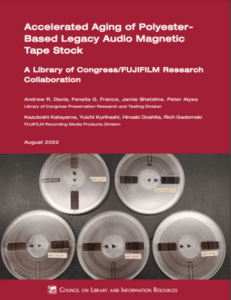 A research report from August of 2022 entitled, Accelerated Aging of Polyester Based Legacy Audio Magnetic Tape Stock published by the Council on Library and Information Resources, documents the results of a joint research effort between the Preservation Research and Testing Division of The Library of Congress and Fujifilm’s Recording Media Division.
A research report from August of 2022 entitled, Accelerated Aging of Polyester Based Legacy Audio Magnetic Tape Stock published by the Council on Library and Information Resources, documents the results of a joint research effort between the Preservation Research and Testing Division of The Library of Congress and Fujifilm’s Recording Media Division.
The genesis of the research was a casual “what if” conversation between Library of Congress archivists and Fujifilm data storage team members at a symposium on long term data storage back in 2014. Fujifilm agreed to apply modern data tape testing techniques to vintage audio tape to help the Library develop a better understanding of the physical mechanisms through which magnetic audio tape degrades over time. This is an important issue for The Library as it holds a collection of over a half million audio recordings, much of it dating back to the 1970s and 1980s.
One of the main takeaways from this research conducted over many years at our data tape lab in Odawara, Japan is that playable audio tape is not likely to degrade to an unplayable state for up to 100 years if stored at standard room temperature and humidity (68 – 75 degrees F, 30 -60% RH). Prior to this modern accelerated testing, the prevailing guidance was 10 to 30 years of life expectancy. Armed with the new information from this research, institutions involved in preservation of cultural heritage on magnetic tape can better plan how and when they need to migrate this content to modern digital tape formats such as LTO Ultrium or IBM 3592.
To me, this paper speaks to the reliability of tape technology, be it audio, video or data; vintage or modern day.
You can read the full report here.
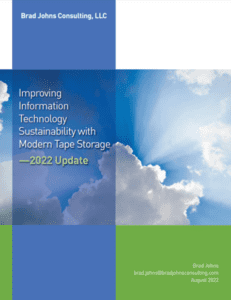 A landmark whitepaper published in July of 2021 by Brad John’s Consulting entitled, Improving Information Technology Sustainability with Modern Tape Storage, found that:
A landmark whitepaper published in July of 2021 by Brad John’s Consulting entitled, Improving Information Technology Sustainability with Modern Tape Storage, found that:
In August 2022, Brad Johns Consulting updated his analysis to reflect the latest LTO Gen 9, replacing 12.0 TB LTO-8 with 18.0 TB LTO-9 and replacing 16.0 TB HDD with the latest 18.0 TB HDD. Thanks to the higher capacity of LTO-9, the 2022 Update of Improving Information Technology Sustainability with Modern Tape Storage now shows:
Sustainability remains a hot issue (no pun intended) so expect to see the topic even more pronounced throughout 2023 as sustainability is becoming mission-critical for eco-friendly organizations across the globe and in every market vertical from HPC to SMB and beyond.
You can read the full report here.
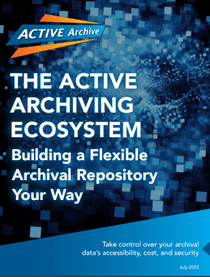 The Active Archive Alliance released its 2022 annual report in July 2022 entitled, The Active Archiving Ecosystem: Building a Flexible Archival Repository Your Way, highlighting the increased demand for new data management strategies and the benefits and innovations of active archive solutions. Top innovations within active archiving include Artificial Intelligence and Machine Learning (AI/ML), sustainability, analytics, and compliance.
The Active Archive Alliance released its 2022 annual report in July 2022 entitled, The Active Archiving Ecosystem: Building a Flexible Archival Repository Your Way, highlighting the increased demand for new data management strategies and the benefits and innovations of active archive solutions. Top innovations within active archiving include Artificial Intelligence and Machine Learning (AI/ML), sustainability, analytics, and compliance.
AI/MLOps integrates AI and ML to manage large-scale data storage, including sizeable active archive ecosystems. AI/MLOps monitors and applies predictive analytics on system operations such as storage system utilization, archival data monitoring, and policy-driven data movement. Active archive makers may develop and build AI/ML into their workflows or partner with vendors specializing in archival AI/ML across multi-vendor systems.
When it comes to sustainability, tape storage is particularly suited to saving energy costs. By adding a tape system to the active archiving environment, IT can reduce energy consumption and CO2 emissions over other types of storage media. Tape can reduce energy consumption by 87% and CO2e emissions by 95% compared to spinning disks on-premises and in the cloud.
Analytics software is critical for organizations seeking to understand, manage, and gain value from their data. In archiving, analytics drives data awareness and cost implications of moving data to optimal storage throughout its lifetime. Analytics also plays a mission-critical role in mining business intelligence from archives. For example, more healthcare organizations want to mine archived data to improve patient safety, treatments, and outcomes.
Compliance is not only about retention schedules and data protection but also about protecting data accessibility and compliance despite disruptions like changing regulations, acquisitions, or storage system replacements. Active archiving supports this level of compliance with its virtual repository and close monitoring and analytics. Active archiving also supports legal defensibility by acting as the system of record.
You can read the full report here.
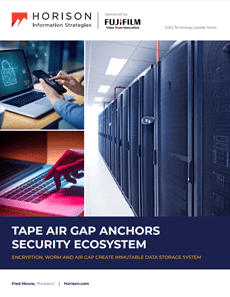 Fred Moore of Horison Information Strategies published a new white paper in June of 2022 entitled, Tape Air Gap Anchors Security Ecosystems.
Fred Moore of Horison Information Strategies published a new white paper in June of 2022 entitled, Tape Air Gap Anchors Security Ecosystems.
No computer system is immune from cybercrime and new types of threats are being discovered every day. With a cease-fire in the cybercrime war highly unlikely, we are witnessing the rapid convergence of data protection and cybersecurity to counter damaging cybercrime threats and ransomware attacks. Emails deliver most of all cybercrime infections with 96% of phishing attacks arriving by email, initially landing on your computer’s HDDs or SSDs – but not on air gapped (offline) storage devices. In addition to tape’s value to online applications such as an active archive, modern tape is clearly the preferred offline storage technology for today’s data centers. Though tape has been an air gapped technology since its inception, the growing cybercrime wave has positioned air gapped tape storage squarely in the middle of the cyber security ecosystem as data cannot be hacked when stored behind a physical air gap. Today’s most effective cyber security strategies include air gapped tape.
You can read the full report here.
 The Tape Storage Council, (TSC), released its annual report in May 2022 entitled, Tape to Play Critical Roles as the Zettabyte Era Takes Off, which highlights the current trends, usages and technology innovations occurring within the tape storage industry. The zettabyte era is in full swing generating unprecedented capacity demand as many businesses move closer to Exascale storage requirements. According to the LTO Program, 148 Exabytes (EB) of total tape capacity (compressed) shipped in 2021, marking an impressive record year. With a growth rate of 40%, this strong performance in shipments continues following the previous record-breaking 110 EB capacity shipped in 2019 and 105 EB of capacity shipped in the pandemic affected year of 2020.
The Tape Storage Council, (TSC), released its annual report in May 2022 entitled, Tape to Play Critical Roles as the Zettabyte Era Takes Off, which highlights the current trends, usages and technology innovations occurring within the tape storage industry. The zettabyte era is in full swing generating unprecedented capacity demand as many businesses move closer to Exascale storage requirements. According to the LTO Program, 148 Exabytes (EB) of total tape capacity (compressed) shipped in 2021, marking an impressive record year. With a growth rate of 40%, this strong performance in shipments continues following the previous record-breaking 110 EB capacity shipped in 2019 and 105 EB of capacity shipped in the pandemic affected year of 2020.
The ever-increasing thirst for IT services has pushed energy usage, carbon emissions, and reducing the storage industry’s growing impact on global climate change to center stage. Plus, ransomware and cybercrime protection requirements are driving increased focus on air gap protection measures. As a result of these trends, among others, the TSC expects tape to play an even broader role in the IT ecosystem going forward as the number of exabyte-sized environments grow. Key trends include:
Organizations continue to invest in LTO tape technology thanks to its high capacity, reliability, low cost, low power consumption and strong data protection features, especially as threats to cybersecurity soar.
